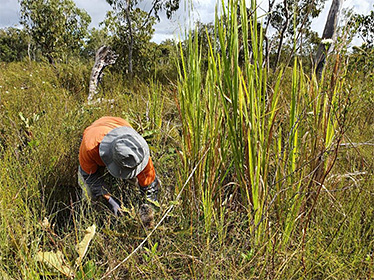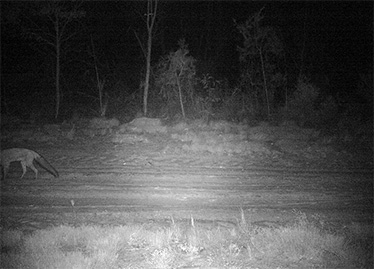Cooloola—Threat management
Protecting habitats from future bushfire

The broad extent of the 2019–20 bushfires across Cooloola was a result of preceding and prolonged drought, above average daytime temperatures, very low relative humidity and gusty winds, resulting in dangerous fire conditions.
To reduce the risk of a future bushfire impeding recovery of burnt Cooloola habitats and priority threatened species, a range of actions were undertaken, in addition to the normal fire management program. The fire strategy review was accelerated, 6 fire lines were reinstated over almost 24kms and planned burns were conducted across 2,236ha of fire-adapted vegetation. These actions provided more effective access for an emergency response to bushfire and a greater ability to limit the progression of fire into recovering habitats, such as that for the southern emu-wren and ground parrot.
Controlling invasive weeds

After fire, invasive weeds can quickly establish in new areas and expand their dominance, hindering the natural regeneration process. The low fertility, sandy soils characteristic of Cooloola fortunately provide less favourable conditions for the growth of many exotic plants. However, there are species that can succeed (such as Bitou bush) and there are other areas of the park with more fertile soils that can support rapidly expanding weed populations. The high level of recreational 4WD use at Cooloola poses a significant risk of spreading weeds along tracks, allowing further incursion into the park.
During 2020–21, over 50 hectares of Cooloola was treated for weeds. This included targeting areas and species that presented the greatest risks of dispersing into burnt areas that were recovering naturally. A series of vehicle tracks were also treated, targeting those weeds with readily transported seeds, such as giant’s rats tail grass, whiskey grass and thatch grass. These efforts will be ongoing as part of the broader park weed management priorities.
Controlling pest animals


At Cooloola, feral pigs are of concern to the recovery of threatened species populations and their habitats. Pigs are attracted to the extensive wetland habitats and can have significant ecological impacts on a wide range of native flora and fauna species. This includes destruction of vegetation, degrading water quality for aquatic species, trampling on and consuming small animals and potentially spreading disease and weeds.
Following the 2019–20 bushfires, pig trapping was successfully undertaken in key locations across Cooloola to remove 26 pigs from the park. Pig trapping will continue in collaboration with the Noosa Shire Council which manages adjoining lands, to sustain pressure on the local feral pig populations.
Foxes have also been known to occur in the Cooloola area and presented an increased risk of predation to threatened species recovering from the fires, particularly the ground parrot and the southern emu-wren. Camera traps were deployed to assess the presence of foxes across multiple locations to identify the best areas for pest management efforts. As a result, 18 foxes and 2 fox dens were lethally controlled, which will support the breeding and recruitment of the priority species and other local wildlife.


